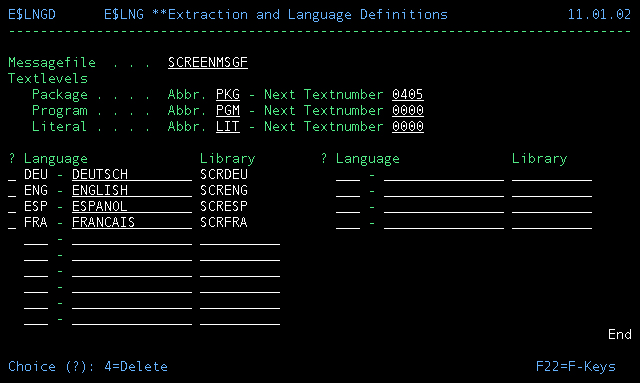E$LNGD - Definitions for Extraction & Languages
Start Command
- call e$lngd
Call Parameters
- *N/A
Return Parameters
- *N/A
What it does
- With this program you define all the parameters needed to be able to make your software language independent. The program has only one screen to fill out.
- You must create the Language libraries before you start this program, because this program does not create those libraries.
- Data is stored in two files (E$LNGDT1 and E$LNGDT2) and it is up to you to find a good location for them:
- E$LNGDT1 is only used by the extraction software: E$LNG.
- E$LNGDT2 should be available to all users and batch printing software, because both users and batch printing software need the possibility to switch languages.
File E$LNGDT1
- messagefile (a10)
- Here you type the name of the message file which should be present in each language library. The message file is automatically created in the Language libraries you define. If it already exists, nothing happens.
- textlevels - abbr. (a3)
- In these fields you can specify your own message prefix for the three levels of extraction. Use a different name for each level, otherwise things might get mixed up.
- textlevels - next textnumber (a4)
- Here you see the next hexadecimal message identifier number to be given away to a new literal. If something has gone wrong, or you need to do it all over, you can correct the starting number here.
File E$LNGDT2
- language (a3 - a15)
- This the language abbreviation and the short name of the language in the language itself, because of the user who will search for his or her own language.
- library (a10)
- The name of the language library you created and where messagefile will be created when you press ENTER. The name is free, but I suggest tio use some naming convention.
Special Options
- ? (d1)
- 4 - Delete
- This deletes the chosen record from the file and subfile.
Examples

Go to download page




 Transportation Administration System
Transportation Administration System Snoezelen Pillows for Dementia
Snoezelen Pillows for Dementia Begeleiders voor gehandicapten
Begeleiders voor gehandicapten Laat uw hond het jaarlijkse vuurwerk overwinnen
Laat uw hond het jaarlijkse vuurwerk overwinnen Betuweroute en Kunst
Betuweroute en Kunst Hey Vos! Je eigen naam@vos.net emailadres?
Hey Vos! Je eigen naam@vos.net emailadres? Kunst in huis? Nicole Karrèr maakt echt bijzonder mooie dingen
Kunst in huis? Nicole Karrèr maakt echt bijzonder mooie dingen Kunst in huis? Netty Franssen maakt ook bijzonder mooie dingen
Kunst in huis? Netty Franssen maakt ook bijzonder mooie dingen